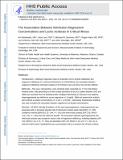| dc.contributor.author | Moskowitz, Ari | |
| dc.contributor.author | Donnino, Michael W. | |
| dc.contributor.author | Danziger, John | |
| dc.contributor.author | Lee, Joonwu | |
| dc.contributor.author | Mark, Roger G | |
| dc.contributor.author | Celi, Leo Anthony G. | |
| dc.date.accessioned | 2017-12-19T20:42:57Z | |
| dc.date.available | 2017-12-19T20:42:57Z | |
| dc.date.issued | 2014-04 | |
| dc.date.submitted | 2013-12 | |
| dc.identifier.issn | 0885-0666 | |
| dc.identifier.issn | 1525-1489 | |
| dc.identifier.uri | http://hdl.handle.net/1721.1/112813 | |
| dc.description.abstract | Introduction: Although magnesium plays an important role in aerobic metabolism and magnesium deficiency is a common phenomenon in critical illness, the association between magnesium deficiency and lactic acidosis in the intensive care unit (ICU) has not been defined. Methods: This was a retrospective, cross-sectional study conducted at a 77 ICU bed tertiary medical center. Data pertaining to the first unique admission of any ICU patient between 2001 and 2008 were extracted from the Multiparameter Intelligent Monitoring in Intensive Care database. Hypomagnesemia was defined as serum magnesium < 1.6 mg/dL. Mild and severe lactic acidosis were defined as lactate concentrations of > 2 and > 4 mmol/L, respectively. Multivariate modeling was used to explore the association between magnesium and lactate concentrations. Results: Of 8922 critically ill patients, 22.6% were hypomagnesemic. Hypomagnesemia was associated with an increased adjusted risk of mild lactic acidosis (odds ratio [OR] 1.71, 95% confidence interval [95%CI] 1.51-1.94, P < .001) and severe lactic acidosis (OR 1.56, 95%CI 1.32-1.84, P < .001) than the reference quartile. The association between hypomagnesemia and mild lactic acidosis was stronger in those at risk of magnesium deficiency, including diabetics (OR 2.02, 95%CI 1.51-2.72, P < .001) and alcoholics (OR 1.92, 95%CI 1.16-3.19, P =.01). As an internal model control, hypokalemia was not associated with an increased risk of lactic acidosis. Conclusions: Magnesium deficiency is a common finding in patients admitted to the ICU and is associated with lactic acidosis. Our findings support the biologic role of magnesium in metabolism and raise the possibility that hypomagnesemia is a correctable risk factor for lactic acidosis in critical illness. | en_US |
| dc.publisher | SAGE Publications | en_US |
| dc.relation.isversionof | http://dx.doi.org/10.1177/0885066614530659 | en_US |
| dc.rights | Creative Commons Attribution-Noncommercial-Share Alike | en_US |
| dc.rights.uri | http://creativecommons.org/licenses/by-nc-sa/4.0/ | en_US |
| dc.source | PMC | en_US |
| dc.title | The Association Between Admission Magnesium Concentrations and Lactic Acidosis in Critical Illness | en_US |
| dc.type | Article | en_US |
| dc.identifier.citation | Moskowitz, Ari et al. “The Association Between Admission Magnesium Concentrations and Lactic Acidosis in Critical Illness.” Journal of Intensive Care Medicine 31, 3 (April 2014): 187–192 © SAGE Publications | en_US |
| dc.contributor.department | Institute for Medical Engineering and Science | en_US |
| dc.contributor.mitauthor | Lee, Joonwu | |
| dc.contributor.mitauthor | Mark, Roger G | |
| dc.contributor.mitauthor | Celi, Leo Anthony G. | |
| dc.relation.journal | Journal of Intensive Care Medicine | en_US |
| dc.eprint.version | Author's final manuscript | en_US |
| dc.type.uri | http://purl.org/eprint/type/JournalArticle | en_US |
| eprint.status | http://purl.org/eprint/status/PeerReviewed | en_US |
| dc.date.updated | 2017-12-19T15:40:54Z | |
| dspace.orderedauthors | Moskowitz, Ari; Lee, Joon; Donnino, Michael W.; Mark, Roger; Celi, Leo Anthony; Danziger, John | en_US |
| dspace.embargo.terms | N | en_US |
| dc.identifier.orcid | https://orcid.org/0000-0001-8593-9321 | |
| dc.identifier.orcid | https://orcid.org/0000-0002-6318-2978 | |
| mit.license | OPEN_ACCESS_POLICY | en_US |
